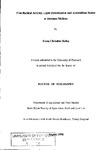Free Radical Activity, Lipid Peroxidation and Antioxidant Status in Diabetes Mellitus
| dc.contributor.author | Belka, Irena Christine | |
| dc.contributor.other | Faculty of Health | en_US |
| dc.date.accessioned | 2013-10-28T11:08:49Z | |
| dc.date.available | 2013-10-28T11:08:49Z | |
| dc.date.issued | 1998 | |
| dc.identifier | NOT AVAILABLE | en_US |
| dc.identifier.uri | http://hdl.handle.net/10026.1/2407 | |
| dc.description | Merged with duplicate record 10026.1/749 on 06.02.2017 by CS (TIS) | |
| dc.description.abstract |
The role of free radicals and antioxidants in human disease, particularly cardiovascular disease is an area of intensive research. Diabetes mellitus is the most common condition associated with increased oxidative stress and accelerated atherosclerosis. Increased levels of lipid peroxides and diminished antioxidant vitamin status have been reported in diabetic patients and are also implicated in the chronic complications of diabetes. The autoxidation and glycoxidation reactions of glucose are sources of free radicals in vitro and a preliminary investigation that these reactions may be a source of free radicals in vivo was undertaken in patients admitted to hospital with severe hyperglycaemia or diabetic ketoacidosis. Plasma lipid peroxides were elevated 2-7 fold above the reference range, but decreased during the recovery period in these patients. Plasma urate and ascorbate levels decreased rapidly, whilst interestingly, α-tocopherol levels /lipid ratios were preserved. The study indicated the resilient nature of the antioxidant defences in plasma, although further studies are required in order to elucidate fully the role of autoxidation and glycoxidation reactions in vivo. Insulin resistance and hyperinsulinaemia are also tightly linked with atherogenesis in type II diabetes and weight loss in obese subjects plays an important part in the reversal of insulin resistance. The safety and efficacy of two weight loss interventions - very low calorie diet (VLCD) and intensive conventional dietetic (I CD) therapy - on cardiovascular risk factors and indices of oxidative stress were investigated in obese diabetic and non-diabetic subjects. The ICD therapy produced modest weight loss in patients with established diabetes with transient improvements in diastolic blood pressure and plasma ascorbate, but with a reduction in vitamin E / serum lipid ratios. The VLCD produced large and rapid weight loss in diabetic and non-diabetic patients with improvements in cardiovascular risk factors, lipid peroxides and vitamin E / serum lipid ratios, which were maintained after 12 months. Plasma ascorbate concentrations were significantly lower in diabetic patients than non-diabetic patients on the VLCD, indicating that formulated diets may require higher concentrations of vitamin C for diabetic patients and this requires further investigation. The VLCD successfully reversed type II diabetes and normalized plasma lipid peroxide levels in two newly diagnosed patients. | en_US |
| dc.description.sponsorship | South Devon Healthcare, Torbay Hospital | en_US |
| dc.language.iso | en | en_US |
| dc.publisher | University of Plymouth | en_US |
| dc.title | Free Radical Activity, Lipid Peroxidation and Antioxidant Status in Diabetes Mellitus | en_US |
| dc.type | Thesis | en_US |
| dc.identifier.doi | http://dx.doi.org/10.24382/1378 |
Files in this item
This item appears in the following Collection(s)
-
01 Research Theses Main Collection
Research Theses Main


